There are seven types of turtles in South Dakota. Of the seven turtles, five are listed as threatened, endangered, or rare. Only the snapping turtle and the painted turtle hold no special status.
Some species are rarely ever sighted. For instance, the Blanding’s turtle has not had a verifiable sighting since the 1960s and it is unclear if they still exist within the state.
Turtles are essential species to the state and it is illegal to collect and hunt any wild turtle which holds a special status. The snapping and the painted turtles can be collected or hunted but only if you hold a hunting and fishing license.
Here is our list of turtles you will find roaming around the state of South Dakota:
Table of Contents
Snapping Turtles in South Dakota
1. Common Snapping Turtle

- Experience level: Intermediate to Expert
- Family: Chelydrida
- Scientific Name: Chelydra Serpentina
- Common Name: Common Snapping Turtle, Snapper, Eastern Snapping Turtle
- Average Adult Size: 8 to 20 inches
- Life Span: 30 – 50 years
- Average Price Range: Approximately $40 to $120
- Conservation Status: No special status in South Dakota, No special status on US Federal List, Least Concern on the IUCN Red List
Common snapping turtles are large freshwater turtles with long necks. Hence the scientific name Serpentina, which relates to the long, serpentine like neck. They are one of the largest turtle species in South Dakota. The carapace length of these turtles is 9 to 20 inches.
They also reach an average weight of 12.8 lb (6 kg). They can however reach weights of 44 lb, which is the weight of the largest specimen recorded in South Dakota.
The tails of the snapping turtle can be almost as long as the carapace length. Their long tails are unusual among the turtles of Dakota as all other species have shorter, stubby tails.
Theis species also has tiny plastrons, a very thick carapace, and a large head. The plastron and the underside of the chelonian are a pale cream color. The head, carapace, and tail are dark in coloration.
The carapace, or upper shell is often covered in algae and moss because this turtle rarely leaves the water. Another defining characteristic on snapping turtles is the tubercles on the limbs and neck of the turtle.
The species has sharp beaks which are capable of causing serious injuries such as broken fingers and deep lacerations. Apart from their vicious beaks, the turtle also has long claws. Although in the water, snappers are rarely aggressive, preferring to swim away rather than confront danger.
The common snapping turtle doesn’t like to leave its watery home, but they do come out of the water on occasions – such as when females have to nest and lay eggs. When they leave, they can travel very long distances. When they find a suitable nesting site, they tend to stay there.
Mating and breeding occur in spring after the turtle has overwintered in organic matter and mud at the bottom of the body of water they inhabit. Females can store the sperm of males for up to two years.
Females will nest in the warm months of June and July. They tend to lay about 20 to 40 eggs in soft, sandy banks near water. The babies will hatch around October or November and from day one, they are on their own.
The snapping turtle is a solitary animal, especially the territorial adult males. Most interactions between rival snapping turtles are generally aggressive.
These turtles can become rather aggressive when on land. This aggression extends to humans and any other potential danger. Once in the water, the snapping turtle usually swims away from perceived threats.
The species can be found in cattle ponds, swamps, marshes, reservoirs, rivers, streams, lakes, and ponds. Occasionally you can find them basking on logs, but most times they hover near the surface to get warm.
The snapping turtle is an omnivorous species although they lean more on the carnivorous side, they prey on animals within their habitat that are smaller than they are. These include fish, snakes, small mammals, and birds. Plants that the species feed on include aquatic vegetation and algae.
They use their sharp claws and powerful jaws to tear carrion and large prey apart before eating. The snapping turtle is an ambush predator who hides in muddy bottoms of its habitat waiting for prey.
In South Dakota, the snapping turtle may be found throughout the state, but their numbers are not tracked. Snapping turtle’s are probably not found around the semi-arid and arid regions of the state because there aren’t many waterholes to be found.
The snapping turtle is considered to be a species of Least Concern on the IUCN Red List and holds no special status on the US Federal List.
Painted Turtles in South Dakota
2. Painted Turtle
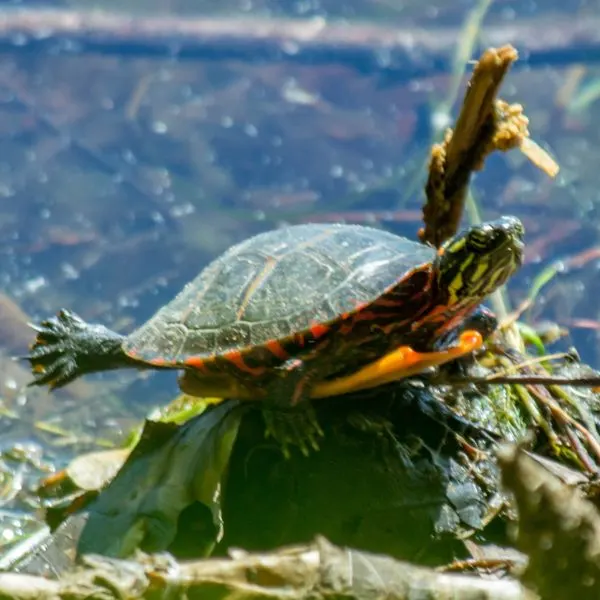
- Experience level: Beginner
- Family: Emydidae
- Scientific Name: Chrysemys picta
- Common Name: N/A
- Average Adult Size: 4 – 10 inches
- Life Span: 30 – 50 years
- Average Price Range: Between $30 to $150
- Conservation Status: No special status in South Dakota, No special status on US Federal List, Least Concern on the IUCN Red List
The painted turtle has bright red and yellow markings along its shell, neck, and head. These markings appear to be painted onto them with a delicate hand. These striking marking are what gives this turtle its common name. These markings tend to fade with age as the olive to black skin gets darker.
The painted turtle is a moderately sized freshwater turtle that can reach an adult carapace length of 4 to 10 inches. Females tend to be larger than males because of this species sexual dimorphism which makes identifying their gender easier as well.
The carapace of this turtle is unkeeled and smooth and has a slight dome shape. The dull green to brown coloration is marked with bright red or yellow lines. The plastron (underside of the turtle) is usually orange or red colored with dark markings along the middle line.
Male painted turtles have thicker tails with a cloacal opening that’s much farther from the carapace edge. Males also have elongated claws on the forelimbs. These are used to entice the female into mating and for holding on during the act.
Mating and breeding occur in spring typically from May to June, and soon after, gravid females dig nests in the soft ground and deposit their eggs. The turtle eggs develop over the next few months and hatch in August.
The painted turtle seems to be able to withstand and occupy nearly any type of freshwater. They prefer places with lots of vegetation that they can hide in and eat.
The turtle is omnivorous and feeds on crustaceans, fish, amphibians, fish, insects, algae, and plants.
They can be found in large reservoirs such as lakes, ponds, rivers, and streams. They can be found in abundance through the Prairie Pothole Region.
You can often see the diurnal turtles basking on logs, rocks, and near the water’s edge in large communities. Turtles will climb on top of each other to find the perfect spot. When they are approached or frightened by predators they will quickly slip back into the water.
When the temperatures start to dip, the painted turtle will bury itself in organic matter and mud at the bottom of the water. Doing so helps them avoid the freezing temperatures of winter.
While brumating, painted turtles can absorb oxygen through their cloaca. When they can surface, they will come up for a few breaths of fresh air, then return to their muddy hole until the temperatures warm up.
The painted turtle holds no special status in South Dakota and as such is not monitored by the South Dakota Game, Fish, and Parks. The species is considered to be a species of Least Concern on the IUCN Red List and holds no special status on the US Federal List.
3. Blanding’s Turtle
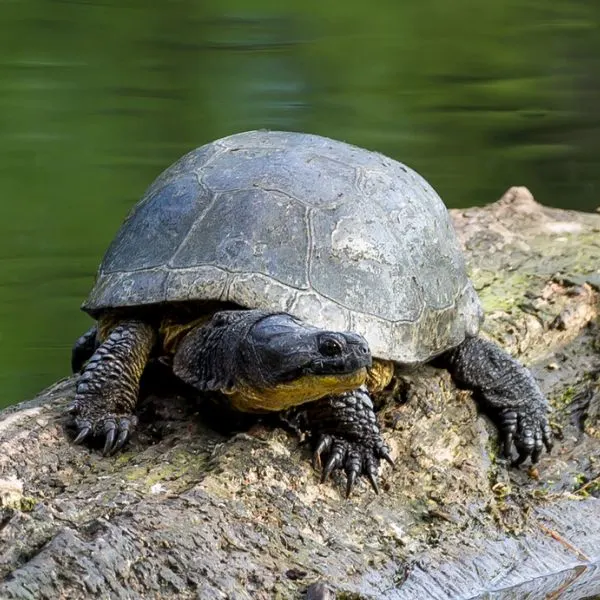
- Experience Level: Intermediate
- Family: Emydidae
- Scientific Name: Emydoidea blandingii
- Other Names: N/A
- Adult Size: 5 to 8 inches (12.5 to 20 cm)
- Lifespan: Up to 80 years
- Average Price Range: $300 to $450
- Conservation Status: Special Concern in South Dakota. Endangered on the IUCN Red List, Global Rank of G4 (Apparently secure), and a State Rank of S1 (Critically imperiled)
The Blanding’s turtle is a medium sized freshwater turtle that can reach a length of 8 inches. The carapace of the turtle is dome-shaped with small yellow flecks like someone splattered paint on it to break up the dull, dark coloration of the shell. The underside/plastron of the turtle is lightly colored with dark blotches on the scutes.
The shell of the Blanding’s turtle is hinged so it can retract its head into the shell, much like box turtles. The throat, neck, and lower jaw of the turtle are bright yellow in coloration, and they have a notched upper jaw.
Another unique characteristic of the Blanding’s turtle is the protruding eyes. They look like their eyes are “bugging out.”
The Blanding’s turtle likes to inhabit permanent bodies of water that have no or very slow currents such as wetlands and bogs. Sandy bottoms and areas with dense aquatic vegetation are also on their list when they look for a home.
These rare turtles are omnivores. The will eat vegetation, frogs, fish, insects, and other aquatic invertebrates. When it presents itself, the Blanding’s turtle will also feed on carrion such as deceased fish.
The Blanding’s turtle is a great swimmer and will often chase down its prey in the water. When it’s not scarfing down tadpoles, worms and other foods they can be found basking on logs, dense vegetation and the bank.
This particular turtle is very rare and in considered endangered. One of the reasons is because they take a long time go reach sexual maturity. It may take a turtle 14 to 20 years to become sexually mature.
Then, when they mate, they only lay between 5 to 12 eggs. And of these, very few make it to adulthood as the babies often get poached because of the pet trade, or the eggs get eaten by predators.
In South Dakota, sightings of the Blanding’s turtle are so rare that some think the original sightings were from released pets. Which is not a good practice as pets may not survive. Then those that do can become invasive species or pass on diseases that native species are not immune to.
Wild populations of Blanding’s turtles have been observed in the neighboring state of Nebraska, near the Sandhills area. It’s possible these species have crossed the state line into South Dakota, but there haven’t been recorded sighting since 1963.
This sighting was also recorded in the Big Bend river, not their natural habitat, which again lends to the thought that it was a released pet.
In South Dakota, Blanding’s turtle is a species of Special Concern. On the IUCN Red List, the species is listed as Endangered. The turtle has a Global Rank of G4 (Apparently secure) and a State Rank of S1 (Critically imperiled).
Map Turtles in South Dakota
4. False Map Turtle
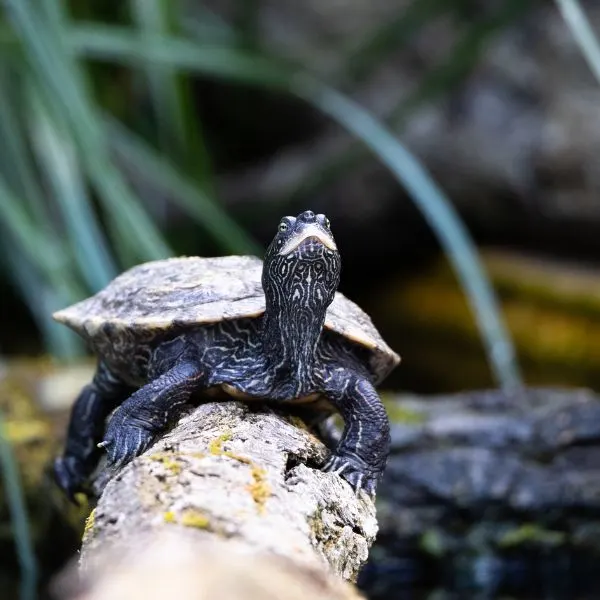
- Experience Level: Beginner
- Family: Emydidae
- Scientific Name: Graptemys pseudogeographica
- Other Names: Sawback turtle
- Adult Size: 3.5 to 10.5 inches (9 to 26.5 cm)
- Lifespan: 30 to 50 years
- Average Price Range: $6 to $40
- Conservation Status: Threatened in South Dakota, no special status on the US Federal list, Least Concern on the IUCN Red List, Global Rank of G5 (Demonstrably secure), and a State Rank of S3 (Rare)
The false map turtle is found in along many branches of the Missouri and Mississippi rivers and along fast moving waters along Texas and Louisiana. Juveniles tend to hang out in backwaters, and areas with more vegetation than adults.
While the false map turtle was once thought to have very healthy populations, there is a remarkable lack of documentation to back this up. It’s assumed that populations are shrinking due to habitat modification. South Dakota considers the false map turtle a threatened species.
The false map turtle has an olive to brown carapace with a prominent ridge running along the middle. When they are born, the carapace is marked by pale yellow lines which look like contours on a map, which tend to fade over time. The skin of the species is also covered in yellow lines.
Other definitive marking include a saw-toothed back end of the carapace, and an identifiable L-shaped mark behind each eye.
To help them navigate the swift-running waters of rivers and streams, they have wide, webbed back feet. Their front feet don’t have these big webs though. They like to spend a lot of time basking in the warm sun and can be found on nearly anything sticking out of the water.
The false map turtle is an omnivorous species, but juveniles tend to be more carnivorous. They eat more insects, tadpoles and small mollusks. As they age, they start adding more vegetation to their diets.
During the winter, false map turtles will bury themselves in the muddy or sandy flats along their river habitats to brumate. Unfortunately dry winters and receding waters can sometimes expose brumating turtles. While they are sluggish because of the cold temps, they are sitting ducks for predators.
In South Dakota, the map turtle has been observed in the counties of Corson, Hughes, Stanley, Buffalo, Gregory, Charles Mix, Douglas, Hutchinson, Bon Homme, Yankton, Clay, and Union. Throughout the rest of North America, the species are known to occur in the Missouri and Mississippi Rivers and the tributaries that feed these two rivers.
The species is considered threatened in South Dakota and are protected by state law. If you see these turtles, it’s unlawful to mess with them or take them from their habitat. The turtle holds no special status on the US Federal list and is considered a species of Least Concern on the IUCN Red List.
Box Turtles in South Dakota
5. Ornate Box Turtle

- Experience Level: Intermediate to Expert
- Family: Emydidae
- Scientific Name: Terrapine ornata
- Other Names: Box Tortoise, Western Box Turtle
- Adult Size: 4 to 5 inches (10 to 12.5 cm)
- Lifespan: 30 to 40 years
- Average Price Range: $150 to $450
- Conservation Status: Special Concern in South Dakota, Near Threatened on the IUCN Red List, Global Rank of G5 (Demonstrably secure), and a State Rank of S2 (Imperiled)
The ornate box turtle is a terrestrial species that spends its time in grasslands and pastures though it can hang out around aquatic wetlands. Much of the time the ornate box turtle likes to hide away in burrows.
The ornate box turtle will dig its own burrow, and so they look for lands with sandy, soft ground they can easily dig through.
Bright yellow lines mark each scute on the turtle’s highly-domed carapace. Box turtles have a hinged plastron that allows them to fully retract themselves into the shell when threatened. This protects them from most predators when they are fully grown, though they have no defense against cars.
When they try to cross the road, many box turtles meet their doom because they are so slow moving, or they hide in their shell when they see something large coming their way. Be careful along roadways and look out for these little beauties.
If you see a turtle crossing the road and feel compelled to help it across, be sure to put in on the side of the road they were facing. If the turtle gets set on the opposite side, it will just turn around and attempt the road crossing again.
One way to tell a male from a female ornate box turtle is to look into their eyes. Though these little cuties may hypnotize you, they mean no harm. Anyway, females have yellow or brown eyes, and males have red eyes.
The ornate box turtle is an omnivore and feeds on plant matter such as flowers, berries, and leaves. They also eat carrion, worms, insects, and nearly anything smaller than they are.
Before winter comes, ornate box turtles will dig a deep burrow and brumate until mid spring. When they leave these burrows they become homes and hiding places for many other species of animals.
Ornate box turtles start mating in May and lasts through the summer. Females lay from 2 to 8 eggs in sandy nests they dig out.
They have been observed in Pennington, Oglala Lakota, Fall River, Bennett, Jackson, Todd, and Tripp. Within the rest of North America, the species can be found throughout the great plains. They can be located from South Dakota to Texas and Mexico.
The ornate box turtle is considered to be a species of Special Concern in South Dakota. The turtle is also considered to be Near Threatened on the IUCN Red List of Threatened Species.
Softshell Turtles in South Dakota
6. Smooth Softshell Turtle
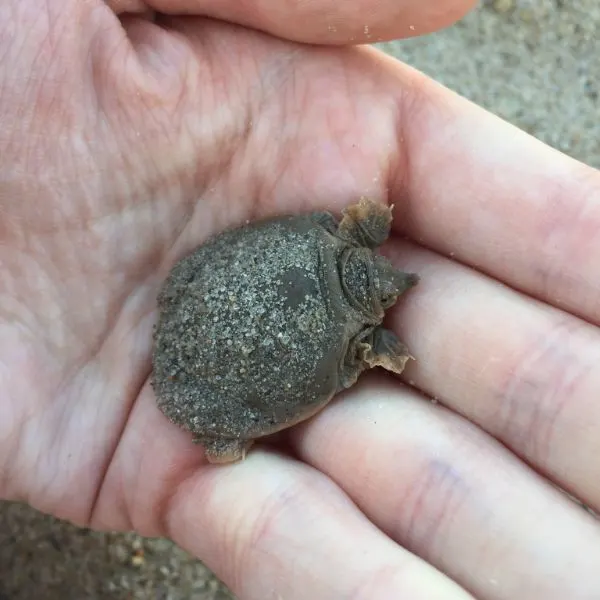
- Experience Level: Intermediate to Expert
- Family: Trionychidae
- Scientific Name: Apalone mutica
- Other Names: Spineless Softshell
- Adult Size: 4.5 to 14 inches
- Lifespan: 25+ years
- Average Price Range: $40 to $60
- Conservation Status: Special Concern in South Dakota, Least Concern on the IUCN Red List, Global Rank of G5 (Demonstrably secure), and a State Rank of S2 (Imperiled)
The smooth softshell is one of the softshell turtles that can be found in South Dakota. As you may have already guessed, these turtles are called softshells because of their leathery carapace.
Instead of a hard shell, these turtles have soft, flattened, leathery or rubbery coverings. These aquatic turtles can grow quite large with females being much larger than males. Adult females reach lengths of 7 to 14 inches while adult males are about half their size, reaching carapace lengths of 5 to 7 inches.
The carapace and skin along the head, neck, and limbs is usually tan in coloration. While females have tan carapaces with dark brown mottlings, adult males have dark streaks and spots on their shells.
The smooth softshell is a swift swimmer and are nearly as quick on the land. When confronted on the land they can hiss and try to bite as they know they don’t have much in the way of defence. They love to bask, but being shy and reclusive, you may not see anything more than ripples when you come across them.
They have wide, paddle-like front and back feet. They also have three long, sharp claws on their front feet that they use to defend themselves or to rip apart food into smaller bite sized pieces.
Smooth softshell turtles prefer clean streams, rivers, lakes and reservoirs. They look for soft bottoms where they can hide in wait and ambush prey when it comes along. The softshell turtle will also stretch it’s unusually long neck up and use the long snorkel nose to breathe.
While the species feeds on both animals and plants, they are primarily carnivorous, preferring to feed on carrion, amphibians, mollusks, and snails.
In South Dakota, the species can be found in the Missouri River and its large tributaries that feed the river, they have been observed in the following counties – Corson, Walworth, Dewey, Sully, Stanley, Hughes, Lyman, Brule, Gregory, Charles Mix, Bon Homme, Yankton, Lincoln, Clay, and Union.
Apalone mutica is considered to be a species of Special Concern in South Dakota, and if you happen to see them, you are urged to report them to South Dakota Game, Fish and Parks.
The turtle is also considered to be a species of Least Concern on the IUCN Red List of Threatened Species. The species holds no special status on the CITES and the US Federal List.
7. Spiny Softshell
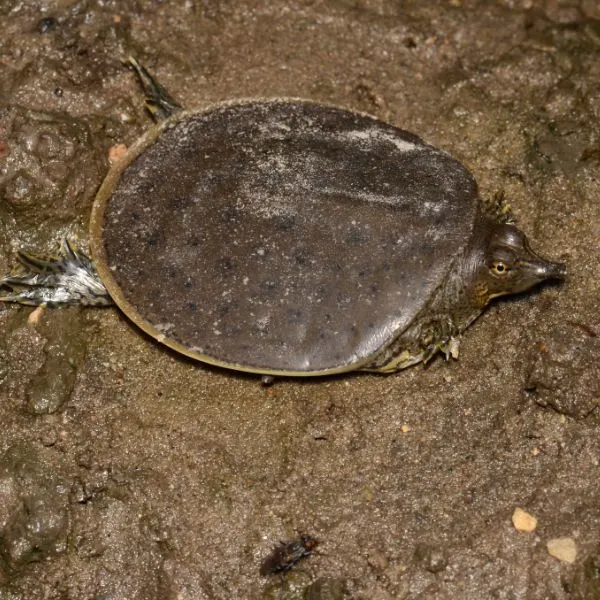
- Experience Level: Intermediate to Expert
- Family: Trionychidae
- Scientific Name: Apalone spinifera
- Other Names: N/A
- Adult Size: 5 to 9 ½ inches for males, 10 to 20 inches for females
- Lifespan: Between 20 and 50 years
- Average Price Range: Between $20 and $120
- Conservation Status: Special Concern in South Dakota, Least Concern on the IUCN Red List, Global Rank of G5 (Demonstrably secure), and a State Rank of S2 (Imperiled)
The spiny softshell turtle is very similar to the smooth softshell turtle except they can get slightly larger and they have rough spines or tubercles along the front ridge of their shell. Their shells have been described as feeling something similar to sandpaper.
Male spiny softshells have dark circular spots or splotches on the carapace while female tend to have smaller black dots or markings. Juveniles have more markings that fade as they reach adulthood.
Sexual dimorphism is easily noticeable in spiny softshell turtles. This means that there is a significant size difference between males and females. Males are generally only half the size of the large female turtles.
It’s thought that the difference is because females have to carry batches of eggs as they develop and get ready to be deposited.
Like the smooth softshell, “spinys” spend much of their time in the water, only coming out to bask or lay eggs in soft, sandy, water banks.
In June, females will lay between 12 to 18 eggs. The eggs incubate for approximately 2 months then emerge in August and head straight for the water.
Predators of baby spiny softshell turtles include raccoons, foxes, skunks, herons, and large fish. Once they reach adulthood, there aren’t many animals that can take them on because they get so large.
The spiny softshell can be found in large rivers in South Dakota; these include the Missouri, White, Whetstone, Vermillion, Minnesota, Keya Paha, James, Cheyenne, Big Sioux, and Belle Fourche Rivers. Along the Missouri River, the smooth softshell is more common.
The spiny softshell is considered to be a species of special concern in South Dakota. The spiny softshell is listed as a species of Least Concern on the IUCN Red List of Threatened Species.
The species holds no special status on the US Federal List.
Frequently Asked Questions
Can turtles survive cold winters in South Dakota?
Turtles are found on all continents of the world, and in oceans and seas, except Antarctica. So yes, turtles can survive cold winters, just not areas that are constantly below freezing.
In cold areas such as South Dakota, turtles will hibernate, or brumate to protect themselves from freezing temperatures. They do this in different ways. Some will hunker down in muddy bottoms, while others dig burrows to protect themselves from freezing temperatures.
Brumation is similar to hibernation, except reptiles such as turtles don’t enter a deep sleep, instead they go into a state of limited activity and slow down their metabolism. They may come out to eat and bask in the sun on warmer winter days.
Can you keep a turtle as a pet in South Dakota?
Laws regarding keeping turtles as pets are quite strict and can be confusing. While it is legal to keep turtles as pets, it is illegal to buy, sell, barter, or trade any turtle species. The commercial activity of turtles is considered illegal.
You can own turtles in South Dakota, you’ll just have to purchase them from out of state. Anc you certainly shouldn’t take them from the wild, unless you are hunting snapping turtles or painted turtles, but you need a Fishing/Hunting license for that.
All the other turtles are protected as the species are either threatened or hold a status of Special Concern.
Are turtles in South Dakota dangerous?
While turtles are not inherently dangerous, when threatened they can cause harm, or cause sickness indirectly.
Reptiles including turtles carry salmonella in their digestive systems. When you handle a reptile, there is a risk of transmitting salmonella to yourself or others. While it’s not recommended to handle turtles in the wild, you should wash your hands whenever you do.
Additionally, snapping turtles and the softshell turtles have powerful bites, with very sharp jaws. These can cause painful lacerations and possibly even broken bones.
These two can become quiet aggressive out of the water. While most other turtles on this list aren’t frequently aggressive, nearly any animal can bite if threatened or harmed.
Wrapping up
There are seven turtles native to South Dakota and these include the common snapping turtle, painted turtle, false map turtle, Blanding’s turtle, ornate box turtle, smooth softshell, and spiny softshell.
Many of the turtles endemic to South Dakota hold special status and are illegal to hunt or collect even with a fishing and hunting license. Only the snapping turtle and the painted turtle hold no special status.
Also, the commercial trade, sale, or purchase of turtles is not allowed in South Dakota.
If you have a comment we would love to hear from you. Do you have a fun or interesting turtle story you’d like to share, then drop a comment below!
More turtles in nearby states
- Turtles in Iowa
- Turtles in Minnesota
- Turtles in Montana
- Turtles in Nebraska
- Turtles in North Dakota
- Turtles in Wyoming
